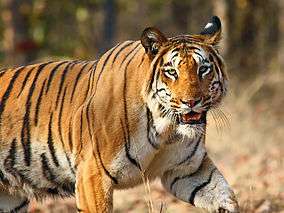Yamuna biodiversity park
Yamuna biodiversity park,[1] located on Yamuna river front is a 9770 hectares biodiversity area in Delhi, India.Arjuni/Mor Biodiversity Park[2][3][4][5] It is developed by Delhi Development Authority (DDA) with the technical help of Centre for Environmental Management of Degraded Ecosystems (CEMDE), University of Delhi.[6] It serves as an ideal alternative habitat for migratory and resident bird species. It also is designed to conserve the wild genetic resources of agricultural crops and enhance groundwater recharge and augment freshwater availability.
| Yamuna biodiversity park | |
|---|---|
| Type | Natural area |
| Location | Jagatpur Khadar, Yamuna, Delhi |
| Nearest city | Sangam Vihar |
| Coordinates | 28.7341761°N 77.2146663°E |
| Area | 9770 hactares |
| Created | 2015 |
| Operated by | Delhi Development Authority |
| Status | Open |
History
| Part of a series on the |
| Wildlife of India |
|---|
 |
|
Biodiversity
|
|
|
|
Organisations
Ministry of Environment
and Forests
World Society for the
Protection of Animals (WSPA) |
Delhi has 7,884 hectares of fragmented forests which are deprived of wild animals due to the unplanned urbanisation and of the 400 wetlands fewer than 3 or 4 were left. In 2015, Delhi already had Aravalli Biodiversity Park and Yamuna biodiversity park. Delhi Development Authority (DDA) engaged the scientist of Delhi University to develop four more biodiversity parks in Delhi, including the Northern ridge biodiversity park (Kamla Nehru Ridge), Tilpath valley biodiversity park, Neelahauz biodiversity park and phase-2 of the Yamuna Biodiversity Park.[4] Phase-I of Yamuna biodiversity park focused on barren floodplains commenced in 2005 and phase-2 focused on the active floodplains commenced in 2015.[7]
Restoration
In 2005 restoration of floodplains of Yamuna commenced, which had been lying barren due to sodic soil making it difficult for plants to grow. In Phase-I, 157 acres ecosystem was restored by developing two wetlands, a grassland and forest communities. Native plant species were reintroduced to reduce the salt content in the soil.[7] The pH level (scale of acidity) of the soil was not neutral and detrimental to the success of the native Indian plants. Researchers form Delhi University had to plant one specific species of grass that brought the pH level from 10 to seven (neutral) level.[8]
Flora
According to prof. C R Babu of Delhi University, initially only mongooses, lizards and 31 species of birds were there in the park up until 2004.[8] By 2014 the biodiversity park already had 900 species of native plants. The native species reintroduced included adina, sal, teak and hardwickia .[7] As of 2019, it has about 1,500 species of plants and animals, and 200 species of birds.[8]
Fauna
By 2014, the wetlands was already attracting thousands of migratory birds from Siberia, Central Asia Asia and Europe. It had 200 species of birds, 75 species of butterflies, 10 species of snakes, and big mammals like porcupine, small Indian civet and wild boars.[7]
See also
- Delhi Ridge
- National Parks & Wildlife Sanctuaries of Haryana
References
- Koner, Kamalkant (7 December 2010). "The Butterfly Park in Yamuna Biodiversity Park". The Economic Times. India: The Economic Times. Retrieved 16 January 2019.
- "Yamuna Biodiversity Park: Leopard captured, to be taken out of capital". The Indian Express. India: The Indian Express. 11 December 2016. Retrieved 16 January 2019.
- "A wildlife success story? Leopard caught on camera at Yamuna Biodiversity Park". hindustantimes.com/. India: Hindustan Times. 23 November 2016. Retrieved 16 January 2019.
- cientists engaged develop four biodiversity parks, Deccan Herald, 23 August 2015.
- DDA biodiversity parks.
- Jain, Ashok Kumar (2009). Low Carbon City: Policy, Planning and Practice. India: Discovery Publishing House. p. 329. ISBN 8183564682.
- Government takes steps to restore biodiversity of Kamala Nehru ridge, Millennium Post, 14 oct 2014.
- From barren land to rich ecosystem: Story behind Yamuna Biodiversity Park, The Indian Express, 23 May 2019.